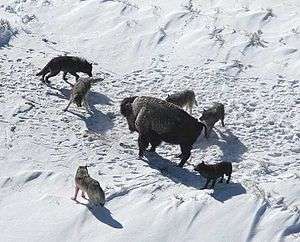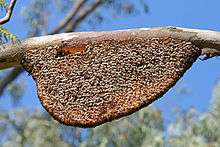Sociality
| Look up sociality in Wiktionary, the free dictionary. |

Sociality is the degree to which individuals in an animal population tend to associate in social groups and form cooperative societies.
Sociality is a survival response to evolutionary pressures.[1] For example, when a mother wasp stays near her larvae in the nest, parasites are less likely to eat the larvae.[2] Biologists suspect that pressures from parasites and other predators selected this behavior in wasps of the family Vespidae.
This wasp behaviour evidences the most fundamental characteristic of animal sociality: parental investment. Parental investment is any expenditure of resources (time, energy, social capital) to benefit one's offspring. Parental investment detracts from a parent's capacity to invest in future reproduction and aid to kin (including other offspring). An animal that cares for its young but shows no other sociality traits is said to be subsocial.
An animal that exhibits a high degree of sociality is called a social animal. The highest degree of sociality recognized by sociobiologists is eusociality. A eusocial taxon is one that exhibits overlapping adult generations, reproductive division of labor, cooperative care of young, and—in the most refined cases—a biological caste system.
Solitary animals, such as the jaguar, don't associate except for courtship and mating. If an animal taxon shows a degree of sociality beyond courtship and mating, but lacks any of the characteristics of eusociality, it is said to be presocial.[3] Although presocial species are much more common than eusocial species, eusocial species have disproportionately large populations.[4]
Presociality
The entomologist Charles D. Michener published a classification system for presociality in 1969, building on the earlier work of Suzanne Batra (who coined the words eusocial and quasisocial in 1966).[5][6] Michener used these terms in his study of bees, but also saw a need for additional classifications: subsocial, communal, and semisocial. In his use of these words, he did not generalize beyond insects. E. O. Wilson later refined Batra's definition of quasisocial.[7]
An example of a species that exhibits presociality is the wasp species Philanthus gibbosus. P. gibbosus exhibits presociality in that it lives communally only for a very short amount of time while establishing a new burrow and at other certain phases of the nesting cycle. Apart from those specific points in the nesting cycle, P. gibbosus has been observed to live completely solitarily.[8]
Subsociality
Subsociality is common in the animal kingdom. In subsocial taxa, parents care for their young for some length of time. Even if the period of care is very short, the animal is still described as subsocial. If adult animals associate with other adults, they are not called subsocial, but are ranked in some other classification according to their social behaviours. If occasionally associating or nesting with other adults is a taxon's most social behaviour, then members of those populations are said to be solitary but social.
Solitary but social

Solitary-but-social animals forage separately, but some individuals sleep in the same location or share nests. The home ranges of females usually overlap, whereas those of males do not. Males usually do not associate with other males, and male offspring are usually evicted upon maturity. Among primates, this form of social organization is most common among the nocturnal strepsirrhine species and tarsiers. Some examples of solitary-but-social species are mouse lemurs, lorises, and orangutans.[9]
Parasociality
Sociobiologists place communal, quasisocial, and semisocial animals into a meta-class: the parasocial. What parasocial taxa have in common is that they socialize in a single, cooperative dwelling.[3]
Here is how communal, quasisocial, and semisocial taxa differ: In a communal group, adults cohabit in a single nest site, but they each care for their own young. Quasisocial animals, however, additionally share the responsibilities of brood care.
Quasisocial behaviour has been observed in some Hymenoptera and spider taxa,[10] as well as in some other invertebrates.[3]
Beyond parasociality is eusociality. Eusocial insect societies have all the characteristics of a semisocial one, except overlapping generations of adults cohabit and share in the care of young. This means that more than one adult generation is alive at the same time, and that the older generations also care for the newest offspring.
Eusociality

Eusocial societies have overlapping adult generations, cooperative care of young, and division of reproductive labor. When organisms in a species are born with physical characteristics specific to a caste which never changes throughout their lives, this exemplifies the highest acknowledged degree of sociality. Only two orders in the animal kingdom include highly eusocial taxa: Hymenoptera (ants, bees, sawflies, and wasps) and the infraorder isoptera (termites). Eusocial species that lack this criterion of morphological caste differentiation are said to be primitively eusocial.[3]
Two potential examples of primitively eusocial mammals are the naked mole-rat and the Damaraland mole-rat (Heterocephalus glaber & Fukomys damarensis, respectively).[11] Both species are diploid and highly inbred, and they aid in raising their siblings and relatives, all of whom are born from a single reproductive queen. They usually live in harsh or limiting environments. However, a study conducted by O’Riain and Faulkes in 2008 suggests that due to regular inbreeding avoidance, mole rats sometimes outbreed and establish new colonies when resources are sufficient.[12]
Eusociality has arisen among some crustaceans that live in groups in a restricted area. Synalpheus regalis are parasitic shrimp that rely on fortress defense. They live in groups of closely related individuals, amidst tropical reefs and sponges.[13] Each group has one breeding female; she is protected by a large number of male defenders who are armed with enlarged snapping claws. As with other eusocial societies, there is a single shared living space for the colony members, and the non-breeding members act to defend it.[14]
Comparison of sociality classifications
| Degree of sociality | Parental investment | Members of an adult generation and their young cohabit | Cooperative care of young | Reproductive division of labour | Caste system | Overlapping adult generations |
|---|---|---|---|---|---|---|
| Subsocial | Yes | No | No | No | No | No |
| Solitary but social | Yes | Sometimes | No | No | No | No |
| Communal | Yes | Yes | No | No | No | No |
| Quasisocial | Yes | Yes | Yes | No | No | No |
| Semisocial | Yes | Yes | Yes | Yes | Yes | No |
| Eusocial | Yes | Yes | Yes | Yes | Yes | Yes |
See also
References
- ↑ Smelser, Neil J.; Baltes, Paul B., eds. (2001). "Evolution of Sociality". International Encyclopedia of the Social & Behavioral Sciences. New York: Elsevier. p. 14506. ISBN 9780080430768. OCLC 47869490.
- ↑ Ross, Kenneth G.; Matthews, Robert W. (1991). The Social Biology of Wasps. Ithaca: Comstock Publishing Associates. ISBN 9780801420351. OCLC 22184337.
- 1 2 3 4 Gadagkar, Raghavendra (September 1987). "What are social insects?" (PDF). IUSSI Indian Chapter Newsletter. International Union for the Study of Social Insects. 1 (2).
- ↑ Nowak, Martin A.; Tamita, Corina E.; Wilson, Edward O. (2010). "The Evolution of Eusociality". Nature. 466 (7310): 1057–1062. doi:10.1038/nature09205. PMC 3279739
 . PMID 20740005.
. PMID 20740005. - ↑ Michener, C. D. (1969). "Comparative Social Behavior of Bees". Annual Review of Entomology. 14: 299–342. doi:10.1146/annurev.en.14.010169.001503.
- ↑ Batra, S. W. T. (1966). "Social behavior and nests of some nomiine bees in India (Hymenoptera, Halictidæ)". Insectes Sociaux. 13 (3): 145–153. doi:10.1007/BF02223020.
- ↑ Wilson, E. O. (1971). The Insect Societies. Cambridge: Belknap Press. ISBN 9780674454903. OCLC 199513.
- ↑ Evans, Howard E. "Burrow sharing and nest transfer in the digger wasp Philanthus gibbosus (Fabricius)". Animal Behaviour. 21 (2): 302–308. doi:10.1016/s0003-3472(73)80071-5.
- ↑ Sussman, R. W. (2003). "Ecology: General Principles". Primate Ecology and Social Structure. Pearson Custom Publishing. p. 29. ISBN 978-0-536-74363-3. OCLC 57408633.
- ↑ Furey, R. E. (1998). "Two cooperatively social populations of the theridiid spider Anelosimus studiosus in a temperate region". Animal Behaviour. 55 (3): 727–735. doi:10.1006/anbe.1997.0648. PMID 9515053.
- ↑ Burda, H. Honeycutt; Begall, S.; Locker-Grutjen, O; Scharff, A. (2000). "Are naked and common mole-rats eusocial and if so, why?". Behavioral Ecology and Sociobiology. 47 (5): 293–303. doi:10.1007/s002650050669.
- ↑ O'Riain, M.J.; Faulkes, C. G. (2008). "African mole rats: eusociality, relatedness and ecological constraints". Ecology of Social Evolution: 207–223. doi:10.1007/978-3-540-75957-7_10.
- ↑ Duffy, J. Emmett; Cheryl L. Morrison; Ruben Rios (2000). "Multiple origins of eusociality among sponge-dwelling shrimps (Synalpheus)". Evolution. 54 (2): 503–516. doi:10.1111/j.0014-3820.2000.tb00053.x. PMID 10937227.
- ↑ Duffy, J. E (1998). "On the frequency of eusociality in snapping shrimps (Decapoda: Alpheidae), with description of a second eusocial species". Bulletin of Marine Science. 63 (2): 387–400.